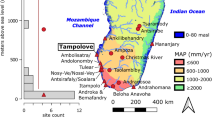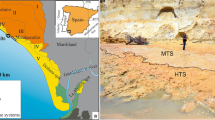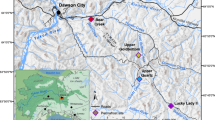Abstract
Long-term monitoring along the Irish Sea coast of Britain at Formby has identified hundreds of animal and human footprints in 31 discrete sediment beds. A new programme of radiocarbon dating shows that the Formby footprints span at least 8,000 years of the Holocene Epoch from the Mesolithic period to Medieval times. In a landscape largely devoid of conventional archaeology and faunal records, we show how species data from the footprint stratigraphy document long-term change in both large mammal diversity and human behaviour. The footprint beds record shifting community structure in the native fauna through an era of profound global change. As sea levels rose rapidly in the Early Holocene, men, women and children formed part of rich Mesolithic intertidal ecosystems from ~9,000 to 6,000 cal bp, with aurochs, red deer, roe deer, wild boar, beaver, wolf and lynx. Doggerland was reclaimed by the sea in this period. In the agriculture-based societies that followed, after 5,500 cal bp human footprints dominate the Neolithic period and later beds, alongside a striking fall in large mammal species richness. Stacked footprint beds can form multimillennial records of ecosystem change with precise geographical context that cannot be retrieved from site-based fossil bone assemblages.
This is a preview of subscription content, access via your institution
Access options
Access Nature and 54 other Nature Portfolio journals
Get Nature+, our best-value online-access subscription
$29.99 / 30 days
cancel any time
Subscribe to this journal
Receive 12 digital issues and online access to articles
$119.00 per year
only $9.92 per issue
Buy this article
- Purchase on Springer Link
- Instant access to full article PDF
Prices may be subject to local taxes which are calculated during checkout






Similar content being viewed by others
Data availability
The data that support the findings of this study are available from the corresponding authors upon reasonable request.
References
Jiang, D., Klaus, S., Zhang, Y.-P., Hillis, D. M. & Li, J.-T. Asymmetric biotic interchange across the Bering land bridge between Eurasia and North America. Natl Sci. Rev. 6, 739–745 (2019).
Bailey, G. et al. in The Archaeology of Europe’s Drowned Landscapes (eds Bailey, G. et al.) 189–219 (Springer, 2020).
Erlandson, J., Braje, T., Gill, K. & Graham, M. Ecology of the kelp highway: did marine resources facilitate human dispersal from northeast Asia to the Americas? J. Isl. Coast. Archaeol. 10, 392–411 (2015).
McLaren, D. et al. Terminal Pleistocene epoch human footprints from the Pacific coast of Canada. PLoS ONE 13, e0193522 (2018).
Woodward, J. C. The Ice Age: A Very Short Introduction (Oxford Univ. Press, 2014).
Pettitt, P. & White, M. The British Palaeolithic: Human Societies at the Edge of the Pleistocene World (Routledge, 2012).
Bell, M. Prehistoric Coastal Communities: The Mesolithic in Western Britain (Council for British Archaeology, 2007).
Gaffney, V., Fitch, S. & Smith, D. Europe’s Lost World: The Rediscovery of Doggerland (Council for British Archaeology, 2009).
Gutiérrez–Zugasti, I. et al. Shell midden research in Atlantic Europe: state of the art, research problems and perspectives for the future. Quat. Int. 239, 70–85 (2011).
Milner, N., Craig, O.E. & Bailey, G. N. Shell Middens in Atlantic Europe (Oxbow Books, 2007).
Neto de Carvalho, C. et al. First tracks of newborn straight-tusked elephants (Palaeoloxodon antiquus). Sci. Rep. 11, 17311 (2021).
Ashton, N. et al. Hominin footprints from Early Pleistocene deposits at Happisburgh, UK. PLoS ONE 9, e88329 (2014).
Duveau, J., Berillon, G. & Verna, C. in Reading Prehistoric Human Tracks: Methods and Material (eds Pastoors, A. & Tilman, L.) 183–200 (Springer, 2021).
Allen, J. R. L. Subfossil mammalian tracks (Flandrian) in the Severn Estuary, S.W. Britain: mechanics of formation, preservation and distribution. Philos. Trans. R. Soc. B 352, 481–518 (1997).
Aldhouse-Green, S. H. R. et al. Prehistoric footprints from the Severn Estuary at Uskmouth and Magor Pill, Gwent, Wales. Archaeol. Cambrensis 141, 14–55 (1992).
Barr, K. & Bell, M. Neolithic and Bronze Age ungulate footprint-tracks of the Severn Estuary: species, age, identification and the interpretation of husbandry practices. Environ. Archaeol. 22, 1–14 (2016).
Bennett, M. R. & Morse, S. A. Human Footprints: Fossilised Locomotion? (Springer, 2014).
Polton, J. A., Palmer, M. R. & Howarth, M. J. Physical and dynamical oceanography of Liverpool Bay. Ocean Dynam. 91, 1421–1439 (2011).
Roberts, G. Ephemeral, subfossil mammalian, avian and hominid footprints within Flandrian sediment exposures at Formby Point, Sefton Coast, North West England. Ichnos 16, 33–48 (2009).
Burns, A. An 8000-Year Record of Prehistoric Footprints in a Dynamic Coastal Landscape, Formby Point, UK. PhD thesis, Univ. Manchester (2019).
Tooley, M. J. Sea level changes in Northern England. Proc. Geol. Assoc. 93, 43–51 (1982).
Pye, K. & Neal, A. in The Dynamics and Environmental context of Aeolian Sedimentary Systems (ed. Pye, K.) 201–217 (Geological Society Special Publication, 1993).
Pye, K., Stokes, S. & Neal, A. Optical dating of aeolian sediments from the Sefton Coast, Northwest England. Proc. Geol. Assoc. 106, 281–292 (1995).
Reimer, P. J. et al. The IntCal20 Northern Hemisphere radiocarbon calibration curve (0–55 cal kBP). Radiocarbon 62, 725–757 (2020).
Walker, M. et al. Subdividing the Holocene Series/Epoch: formalisation of stages/ages and subseries/subepochs, and designation of GSSPs and auxiliary stratotypes. J. Quat. Sci. 34, 173–186 (2019).
Tooley, M. J. The peat beds of the southwest Lancashire coast. Nat. Lancs. 1, 19–21 (1970).
Gonzalez, S., Huddart, D. & Roberts, G. Holocene development of the Sefton coast: a multidisciplinary approach to understanding the archaeology. In Archaeological Sciences 1995 Proc. Conference on the Application of Scientific Techniques to the Study of Archaeology (eds Sinclair, A. et al.) 289–299 (Oxbow Books, 1997).
Huddart, D., Roberts, G. & Gonzalez, S. Holocene human and animal footprints and their relationships with coastal environmental change, Formby Point, NW England. Quat. Int. 55, 29–41 (1999).
Galbraith, H. et al. Global climate change and sea level rise: potential losses of intertidal habitat for shorebirds. Waterbirds 25, 173–183 (2002).
Bellard, C., Leclerc, C. & Courchamp, F. Sea level rise and insular hotspots. Glob. Ecol. Biogeogr. 23, 203–212 (2014).
Editorial Why biodiversity matters. Nat. Ecol. Evol. 1, 0042 (2017).
Hall, J. G. A comparative analysis of the habitat of the extinct aurochs and other prehistoric mammals in Britain. Ecography 31, 187–190 (2008).
Milner, N., Conneller, C. & Taylor, B. Star Carr: A Persistent Place in a Changing World Vol. 1 (White Rose Univ. Press, 2018).
Conneller, C. The Mesolithic in Britain: Landscape and Society in Times of Change (Routledge, 2022).
Hernandez, L. & Laundre, J. W. Foraging in the ‘landscape of fear’ and its implications for habitat use and diet quality of elk (Cervus elaphus) and bison (Bison bison). Wildl. Biol. 11, 215–220 (2005).
Overton, N. J. in Multispecies Archaeology (ed. Pilaar-Birch, S.) 295–309 (Routledge, 2018).
Moore, E. K., Britton, A. J., Iason, G., Pemberton, J. & Pakeman, R. J. Landscape-scale vegetation patterns influence small-scale grazing impacts. Biol. Conserv. 192, 218–225 (2015).
Gonzalez, S. & Huddart, D. in The Quaternary of Northern England (eds Huddart, D. & Glasser, N. F.) 582–588 (Joint Nature Conservation Committee, 2002).
Cowell, R. W. & Innes, J. The Wetlands of Merseyside (Lancaster Univ. Archaeological Unit, 1994).
Leonard, P. B. et al. Landscape connectivity losses due to sea level rise and land use change. Anim. Conserv. 20, 80–90 (2017).
Myers, N. et al. Biodiversity hotspots for conservation priorities. Nature 403, 853–858 (2000).
Stuart, A. J. in Island Britain: a Quaternary Perspective (ed. Preece, R. C.) 111–125 (Geological Society Special Publication, 1995).
Maroo, S. & Yalden, D. W. The Mesolithic mammal fauna of Great Britain. Mammal. Rev. 30, 243–248 (2000).
Yalden, D. W. The History of British Mammals (T. & A.D. Poyser, 1999).
Barnett, R. The Missing Lynx: The Past and Future of Britain’s Lost Mammals (Bloomsbury, 2019).
Crees, J. J., Carbone, C., Sommer, R. S., Benecke, N. & Turvey, S. T. Millennial-scale faunal record reveals differential resilience of European large mammals to human impacts across the Holocene. Proc. R. Soc. B 283, 20152152 (2016).
Burns, A. in Reading Prehistoric Human Tracks (eds Pastoors, A. & Lenssen-Erz, T.) 295–315 (Springer, 2021).
Brown, R., Lawrence, M. & Pope, J. Animals: Tracks, Trails and Signs (Octopus Publishing, 2004).
Donovan, S. K. Animal and bird tracks. Ichnos 16, 238–238 (2009).
Roberts, G., Gonzalez, S. & Huddart, D. Intertidal Holocene footprints and their archaeological significance. Antiquity 70, 647–651 (1996).
Scales, R. in Prehistoric Coastal Communities: The Mesolithic in Western Britain (ed. Bell, M.) 139–159 (Council for British Archaeology, 2007).
Robbins, L. M. Estimating height and weight from size of footprints. J. Forensic Sci. 31, 143–152 (1986).
Stuiver, M. & Polach, H. A. Reporting of C-14 data—discussion. Radiocarbon 19, 355–363 (1977).
Acknowledgements
We acknowledge the pioneering contributions of Gordon Roberts (1930–2016) who was the first to recognize the significance of the Formby footprints and who introduced A.B. to the sites in spring 2009 and was unfailingly generous in his encouragement of her work. We thank N. Scarle of the Cartographic Unit in the School of Environment, Education and Development at The University of Manchester for drawing the diagrams. We also thank colleagues in the Department of Geography laboratories for help with field coring, sediment analysis and the recovery of material for radiocarbon dating. The fieldwork took place when A.B. was a PhD student in the Department of Archaeology and Department of Geography at The University of Manchester supervised by C.C. and J.W. We thank N. Overton and all the students who helped with field survey campaigns. C. Gamble provided very helpful comments on an earlier draft. Funding from the UK Quaternary Research Association (14CHRONO Centre) and the Manchester Geographical Society supported the radiocarbon dating programme. We thank the National Trust for permission to undertake fieldwork along the Formby coast.
Author information
Authors and Affiliations
Contributions
A.B., C.C. and J.W. designed the study. A.B. compiled the Formby footprint database and identified the macrofossils for radiocarbon dating. A.B. and J.W. designed the figures and wrote the paper. P.R. carried out the radiocarbon dating. All authors contributed to data interpretation and editing of the manuscript.
Corresponding authors
Ethics declarations
Competing interests
The authors declare no competing interests.
Peer review
Peer review information
Nature Ecology & Evolution thanks Martin Bell, Silvia Gonzalez and the other, anonymous, reviewer(s) for their contribution to the peer review of this work.
Additional information
Publisher’s note Springer Nature remains neutral with regard to jurisdictional claims in published maps and institutional affiliations.
Extended data
Extended Data Fig. 1 New radiocarbon dates from the Formby footprint beds.
All dates were analysed in the 14CHRONO Centre for Climate, the Environment and Chronology at Queen’s University Belfast and calibrated with the IntCal20 curve24. Calibrated age ranges, rounded out to the nearest 10 years, are given at the 95.4% probability level. Dates in the blue column are used in this paper. The three-stage subdivision of the Holocene approved by the International Union of Geological Sciences is shown25. Locations are shown on Fig. 2b.
Extended Data Fig. 2 OSL and radiocarbon dates obtained from Formby in the 1990s.
Note that grid references have not been published for several of these samples. The seven radiocarbon ages have been calibrated24 so that they are compatible with the 12 new radiocarbon dates presented in this paper (Extended Data Fig. 1). Note that all the radiocarbon dates from tree roots (n = 6) are Late Holocene in age. Figure 2b shows approximate locations of these sites. Much of the earlier work at Formby was done in the 1970s, 80 s, and 90 s and there has been a good deal of erosion in this landscape since. It can be challenging even today to relate the stratigraphy in one part of the coast with another; it is especially difficult with the stratigraphic records studied by previous researchers.
Extended Data Fig. 3 Holocene stratigraphy, radiocarbon dates and footprint record at Wicks Path B.
This is the only site without human footprints. Figure 2b shows the location of this site.
Extended Data Fig. 4 Human footprint data.
Number of human individuals present in the intertidal zone at each footprint site. Data shown by human age categories estimated from footprint form and size.
Extended Data Fig. 5 Animal species data.
Number of individuals by site and context.
Extended Data Fig. 6 Holocene stratigraphy, radiocarbon dates and footprint record at Victoria Road.
Figure 2b shows the location of this site.
Extended Data Fig. 7 Exposure frequency and extent at Formby.
Visibility of the radiocarbon dated footprint beds at Formby over the study period. The highlighted entries show when these beds were exposed at their greatest extent during the seven-year study period (2010–2016).
Supplementary information
Supplementary Information
Supplementary Figs. 1–11, Notes 1 and 2 and Tables 1 and 2.
Rights and permissions
Springer Nature or its licensor holds exclusive rights to this article under a publishing agreement with the author(s) or other rightsholder(s); author self-archiving of the accepted manuscript version of this article is solely governed by the terms of such publishing agreement and applicable law.
About this article
Cite this article
Burns, A., Woodward, J., Conneller, C. et al. Footprint beds record Holocene decline in large mammal diversity on the Irish Sea coast of Britain. Nat Ecol Evol 6, 1553–1563 (2022). https://doi.org/10.1038/s41559-022-01856-2
Received:
Accepted:
Published:
Issue Date:
DOI: https://doi.org/10.1038/s41559-022-01856-2



